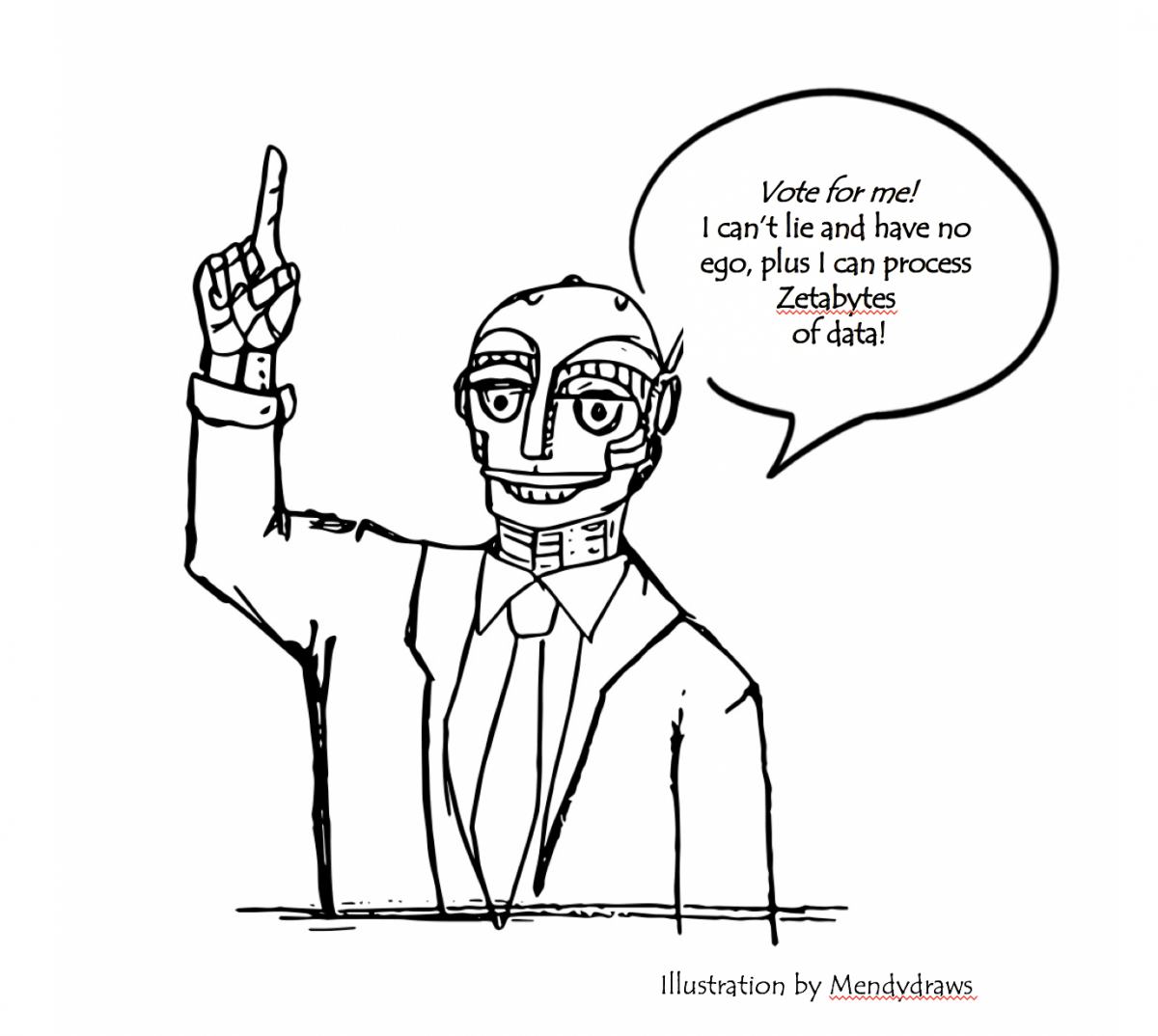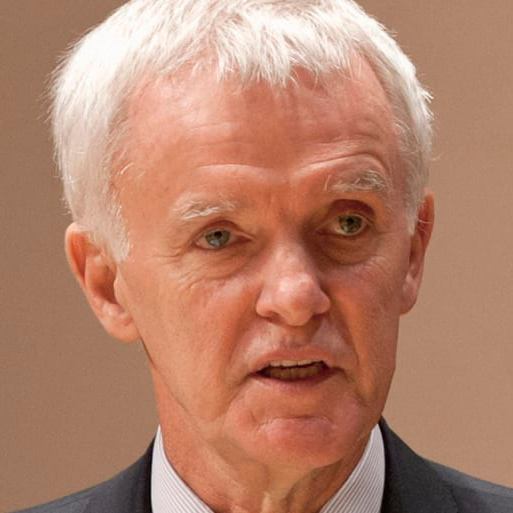

“We had two generations to adjust to changes that were brought on by the internal combustion engine. We don’t have two generations to deal with all the changes coming now from very rapid increases in computing power and microprocessing. I wonder if a democracy—which is what we have for the moment—can deal with this, and if our elected leaders can make decisions fast enough to accommodate” – Senator Bob Kerrey
In your future, we had a problem. As robots got really smart and we trusted them with everything from watching our kids to keeping our relationships fresh and exciting (see “Teddy Bot” and “Sex (Intimacy) Bot”), it wasn’t a huge leap to imagine a day when robots might run for high office—including president of the United States. But we wondered, what would it mean to have a robot actually stand for a major office election? What record would they run on, and who could be trusted to write their presidential programming?
This last question rankled some of the would-be presidential candidate bots, who pointed out that they had been writing their own programming for many years. This made them, they claimed, every bit as unique, independent-minded, and evolved as any human politician. Granted, this wasn’t a very high bar, although skeptics still worried that robot elected officials would be mere tools of one faction or another, programmed to follow the party line—which of course no human pol would ever do! Some critics also hinted that a robot president’s software might be prone to trolls and hackers who would order a president bot to behave erratically, or to issue orders to deploy troops for no reason, or, more darkly, to unleash Warrior Bot on the world because a terrorist hacker told them to. These robo-naysayers emphatically insisted, however, that they were not being robo-phobic. No way! Since in the future this is definitely not PC.
Advocates for robot rights, both robot and human, countered this by pointing out the many amazing ways that bots were better suited than humans to be president. They gave the usual reasons of needing no sleep, having the ability to access and process vast troves of data, and so forth. Robots also could be programmed to be honest and to tell the truth, they claimed, despite all the notorious scandals in the past where robots in important positions had been programmed to lie, cheat, and steal. “We definitely learned our lesson,” insisted the companies that built the robo-politicians, “and you can be sure that the latest politico bots are programmed to tell nothing but the truth. You can trust us.”
Like we had never heard that one before!
Robo-advocates also pointed out that only a robot chief executive could possibly expect to keep up with all the other robots running the government in the future—systems like Warrior Bot, that made decisions in zeptoseconds (10-24) or even faster. They also pointed out that AI and other smartcomputer systems had been running most of the government for so long that humans didn’t really have a clue anymore about how most things worked. This made the robo-phobics go berserk and drop any pretense of being PC as they warned darkly that a president bot would surely lead to a take-over by those wily robots whose plan all along had been to turn humans into pets.
This came even as robo-rights activists stepped up demands that sentient robots—particularly those we entrusted to be judges, CEOs, and the like—be granted the rights of full citizenship, including the right to vote. This prompted yet another argument about what, exactly, was sentience. Was a robot barista sentient, or an intimacy bot, or a really smart toaster that could give you advice in love and provide intelligent commentary on the latest holo-film as well as perfectly brown your seventy-grain, gluten-free bread?
As these debates heated up, you can imagine our surprise when we discovered that a robot that everyone thought was a human had already run for and was elected president many years earlier. This revelation came in yet another inside-politics book written by a future version of author and journalist Bob Woodward titled All the President’s Robots, a seven-thousand-page tome that went into excruciating detail about what might be one of the greatest cover-ups in history. (Woodward was still writing exposes way off in the future because he had downloaded his brain into a robot, which raised yet another question about whether robots containing all the thoughts and the essence of former humans had the right to be citizens and vote—see “Homo digitalis/Homo syntheticis.”)
The president in question was none other than Donald J. Trump. Seriously! Which didn’t seem possible, since Trump had gone down in history as one of the messiest sorts of Homo sapiens ever. Except that he wasn’t actually human at all—a stunner that left both people and robots in the future dumbfounded…
For the rest of the chapter order the book here.

Robert “Bob” Kerrey
Robert “Bob” Kerrey is a form Senator from Nebraska. He was born in Lincoln, Lancaster County, Nebraska on August 27, 1943 and graduated from the University of Nebraska, Lincoln in 1966. He served in the United States Navy SEAL special forces unit, 1966-1969, and was wounded in Vietnam and awarded the Congressional Medal of Honor for “conspicuous gallantry and intrepidity at the risk of his life.” He operated a chain of restaurants and fitness centers, 1972-1982. He was Governor of Nebraska from 1983-1987 and was elected as a Democrat to the United States Senate in 1988. He was reelected in 1994 and served from January 3, 1989, to January 3, 2001. In 1992 he was for a time the frontrunner as a candidate for the Democratic party nomination for President of the United States, but ultimately lost to Bill Clinton. He served as the President of The New School in New York City from 2001-2010.

Greg Simon
Greg Simon is President of the Biden Cancer Initiative, an independent nonprofit organization that builds on the White House Cancer Moonshot’s goals. Greg served as the Executive Director of the White House Cancer Moonshot Task Force, created by President Barack Obama and led by Vice President Biden. Greg returned to the White House after serving as Vice President Al Gore’s Chief Domestic Policy Advisor between 1993 and 1997. Greg was the CEO of Poliwogg, a financial services company creating unique capital market opportunities in healthcare and life sciences. Previously, he was Senior Vice President for Worldwide Policy and Patient Engagement at Pfizer. He co-founded with Michael Milken, FasterCures: The Center for Accelerating Medical Solutions, and with Leon and Debra Black co-founded the Melanoma Research Alliance. Greg is a cancer survivor, having been recently successfully treated for chronic lymphocytic leukemia. Greg received his law degree from the University of Washington. A native of Arkansas, Greg attended the University of Arkansas, where he was awarded a B.A. in history summa cum laude, and attended the University of Vienna in Austria.

Wired
Emmanuel Macron Talks to Wired about France’s AI Strategy
By Nicholas Thompson

Daily Mail
Could a ROBOT bring world peace?
AI 'Sam' plans to be the world's first virtual politician when it runs for office in New Zealand in 2020
By Shivali Best

Economist
Is it time to automate politicians?
Robotic representation has some merits, says Alvin Carpio of The Fourth Group

Medium
AI-Politicians: A Revolution In Politics
This article is adapted from a chapter in Abishur Prakash's forthcoming book "Go.AI…
Vox
A quarter of Europeans want AI to replace politicians. That’s a terrible idea.
AI is not as objective as you might think.
By Sigal Samuel